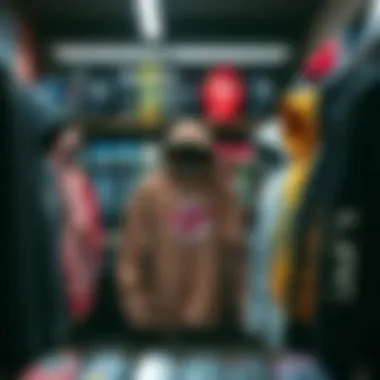Hoodie Shops: A Deep Dive into Skate Culture


Intro
Skateboarding is more than just a sport; it’s a lifestyle, a form of self-expression, and a community. The clothing we choose, particularly hoodies, plays a significant role in the culture surrounding skateboarding. Specialty hoodie shops have become crucial in defining both the style and identity of skateboarders. These shops are not just retail outlets but cultural hubs where the essence of skateboarding is captured and expressed. Through unique designs, high-quality materials, and an understanding of the skating lifestyle, these establishments cater specifically to the needs and desires of skateboard enthusiasts.
As we explore the world of specialty hoodie shops in skate culture, we will delve into their origins, influence on fashion, and connections to the skateboard lifestyle. We’ll also take a closer look at trends that progressively shape the industry and how hoodies go beyond mere clothing to embody a sense of belonging for those who skate.
In this guide, we will cover various aspects that highlight the relationship between hoodies and skateboarding:
- The significance of hoodies within skate culture
- Key features and styles popular among skateboarders
- Emerging trends and their impact on personal expression
- The role of specialty shops in curating the skate aesthetic
This journey will unveil not just the fabric of the hoodies but the very fabric of the skateboarding community. Each section will aim to amplify the understanding of why these shops matter and how they influence the broader culture.
So, whether you are a skateboarder looking for the perfect fit, a parent wanting to understand your child’s passion, or a retailer aiming to connect with this dynamic audience, tread carefully through these insights and immerse yourself in the world of skating apparel.
Preamble to Hoodie Shops
Hoodie shops hold a unique position within the skateboard culture, serving not only as retail spaces but also as gathering spots for skate enthusiasts. The importance of exploring hoodie shops lies in understanding their dual role—providing functional apparel while also reflecting the identity and values of the skater community. As skateboarding continues to evolve, hoodies have become emblematic of the style and ethos that drive the sport.
The significance of hoodies in skateboarding isn’t just in their thermal properties; it's about how they embody the spirit of rebellion and self-expression that characterizes the skate culture. Skaters often use their clothing as a canvas, where each hoodie tells a story of individual taste and brand allegiance. This intricate connection can be seen vividly in specialty shops that curate a distinctive selection tailored to the needs and preferences of the skating community.
Definition and Role in Skateboarding
Hoodies in the skateboarding world serve multiple functions. First and foremost, they are practical. Designed to offer warmth and comfort, these garments are generally made with lightweight materials that allow for ease of movement—essential for executing tricks on a board. Beyond physical utility, they also serve as a form of self-expression. Each design—whether it be a bold graphic or a subtle brand logo—can signify belonging to particular subcultures or movements within the broader skate scene.
In many ways, hoodie shops act as more than just merchandise outlets; they become communal spaces where discussions about tricks, techniques, and lifestyles unfold. They affirm a collective identity that transcends the individual. Skaters gather here not only to purchase hoodies but to share experiences, make connections, and embrace the culture that shapes their passion.
Historical Context of Hoodies in Skate Culture
The journey of hoodies within skate culture traces back several decades. Originally, the hoodie emerged as a practical garment, achieving popularity in various subcultures during the late 20th century. Its transition into the skateboarding scene can be tied to the rising prominence of streetwear. The 1980s and 1990s showcased the rise of skate brands—such as Vans and Thrasher—which began creating hoodies tailored specifically for skateboarders.
"Hoodies represent both warmth in a chilly skate session and the spirit of individuality that underpins skate culture. Whether worn at the park or on the street, they serve as a uniform for those who find freedom on four wheels."
As skateboarding grew in visibility and acceptance, so did the variety of hoodies available. They came to symbolize more than just an outfit; they became part of the identity of skateboarding. By the 2000s, collaborations between skate brands and high-end fashion labels further blurred the lines between streetwear and luxury fashion, cementing the hoodie’s place in not just skateboarding, but in mainstream culture as a whole.
When examining the historical context of hoodies in this scene, one can see how they responded to social and cultural shifts, evolving from a simple piece of clothing to an emblem of lifestyle and attitude in the skateboarding world.
Types of Hoodie Shops
The exploration of specialty hoodie shops presents a fascinating aspect of skate culture, particularly among skateboarders. These shops are not just retail spaces; they are pivotal in defining style, community connections, and the overall skateboard lifestyle. Let's delve into the unique segments that make up this world of hoodie shops, providing insights into their distinct characteristics and how they enhance the skating experience.
Urban Boutiques and their Appeal
Urban boutiques tailored for skateboarders often create a distinct allure through their atmosphere and curated selection. Walking into one of these spaces is like stepping into a realm where creativity thrives. They often feature limited-edition releases, collaborations with local artists, and brands that don't mass produce their goods. This exclusivity resonates strongly with skaters who appreciate individuality and want to stand out.
Moreover, urban boutiques serve as social hubs where like-minded individuals converge. These shops can host events, showcase local skateboard talent, and promote street art, fostering a sense of community that transcends mere consumerism. The experience in an urban boutique often blends shopping with interaction and inspiration, making it more than just a place to buy a hoodie.
Online Retailers: The Digital Shift
The rise of online retailers has changed how skateboarders shop for hoodies and other apparel, introducing convenience and a broader variety of options. These platforms allow customers to compare prices from different brands right from their smartphones, often finding unique items that might not be available in physical stores. With the clicks of a button, you can snag that exclusive graphic hoodie or find a rare collaboration design.
This digital shift also allows for easier access to international brands without the constraints of geographic limitations. However, with great variety comes the challenge of narrowing choices and mitigating the often impersonal nature of online shopping. Many skateboarders find themselves longing for that tactile experience of feeling the fabric or trying on the hoodie before purchasing. Dealing with sizing can be tricky too; what fits like a glove for one brand may feel like a bag to another.
Local Skate Shops and Community Impact
Local skate shops are often the heartbeat of the skateboarding community. They provide not just products but also a sense of place and belonging. Unlike large retail chains, these shops typically reflect the culture, aspirations, and values of their surrounding neighborhoods, making them approachable and genuine.
By supporting local skaters through sponsorship for competitions or organizing community events, these shops play a critical role in strengthening community bonds. They often carry handpicked, high-quality items from local brands that cater specifically to their customers. Plus, the staff—often avid skaters themselves—provide invaluable advice and recommendations based on personal experience. It’s this intimate knowledge and connection that builds trust and loyalty from skateboarders.


"In a world increasingly dominated by giant retailers, local skate shops retain relevance by nurturing a deep-rooted connection with the skaters and their needs."
As we dig deeper into specialty hoodie shops, it's evident that each type brings something unique to the table. The combination of personal touch, community engagement, and evolving retail strategies reflects a rich tapestry of what skate culture is all about.
Design Trends in Hoodies
The hoodie is much more than just a piece of clothing for skateboarders; it is an essential component of their persona. As skateboarding culture evolves, so does the design of hoodies. This section explores how design trends in hoodies reflect individuality, creativity, and the ever-changing landscape of skate style.
Influence of Street Art and Graphics
Street art has long been intertwined with skate culture. Many hoodies sport graphics that are directly inspired by the vibrant art found in urban environments. From oversized prints of graffiti to intricate illustrations of skateboards barreling through abstract landscapes, street art plays an integral role in hoodie design. These graphics serve not only as aesthetic choices but also as a form of self-expression for the wearer.
Hoodies adorned with bold graphics are a way for skateboarders to stand out in a crowd. They can convey statements or personal stories that resonate with other skaters. The visual noise can be the first conversation starter at the skate park, sparking mutual interests among riders. Moreover, collaborations between street artists and hoodie brands have become commonplace, bringing fresh perspectives while promoting local artists.
Fabric Choices and Their Importance
Selecting the right fabric for hoodies is not just a matter of comfort but also of functionality. Skateboarding can be a tough sport that demands durability; thus, the material used in hoodies needs to withstand wear and tear.
Common fabric choices include heavyweight cotton blends and performance-oriented materials that wick moisture. For instance, a skateboarding hoodie made from eco-friendly materials could appeal to enthusiasts who prioritize sustainability alongside activity. Additionally, breathable fabrics ensure that skaters can perform their tricks without overheating.
Here are considerations that influence fabric selection:
- Durability: Heavy fabrics resist damage from abrasions.
- Breathability: Allows airflow, making it ideal for intense sessions.
- Flexibility: Ensures the hoodie does not restrict movement during tricks.
Sustainability in Hoodie Manufacturing
Sustainability is not just a trend; it's an evolving standard in hoodie manufacturing that resonates with many young skateboarders. As awareness grows around environmental issues, many brands are taking steps to create more sustainable products. This can involve sourcing organic cotton or recycled polyester, which reduce the carbon footprint of their hoodies.
Moreover, some companies are committing to ethical manufacturing practices, treating workers fairly in countries where production occurs. Skateboarders are becoming increasingly aligned with these values, opting for brands that demonstrate social responsibility.
In summary, the design trends in hoodies reflect a deeper connection to skateboarding culture. They embody self-expression through graphics, practicality through materials, and ethical considerations through sustainable practices. As skateboarders continue to push boundaries, so too will the hoodies they choose to wear.
Hoodies as Part of Skateboarding Gear
When considering the components of skateboarding gear, one might envision flashy decks, sturdy wheels, and protective helmets. However, there's another staple—a hoodie—that is just as critical, though often overlooked. Hoodies serve not just as a fashion statement; they fulfill essential functions that contribute significantly to the skateboarding experience, weaving seamlessly into the lifestyle of skaters.
Functional Benefits During Skateboarding
Hoodies are designed with certain features that enhance their functionality for skateboarders. Specifically, they offer:
- Warmth and Flexibility: Skateboarding often takes place outdoors, where weather can be unpredictable. A hoodie provides warmth during chilly mornings or evenings without sacrificing mobility, allowing skaters to move freely.
- Durability: Many specialty hoodies are made from robust fabrics that withstand wear and tear. Skaters are prone to falls, and a sturdy hoodie can endure impacts better than traditional sweaters or lightweight joggers.
- Protection from Minor Injuries: While they aren't as protective as pads or helmets, hoodies offer a bit of a buffer against scrapes during a tumble. The fabric can act as a first line of defense against abrasions, especially in urban environments where pavement is often unforgiving.
- Pocket Space: The little things matter. Having pockets can be a huge plus for skaters who carry essential items like keys or small tools while out skating. A well-placed pocket can keep items safe while allowing easy access.
In essence, the functional aspects of hoodies provide comfort and a measure of protection, making them a practical choice for skaters who value both performance and style.
The Balance of Comfort and Style
When it comes to skate culture, style speaks volumes. Hoodies, in this regard, help to strike an essential balance.
- Versatile Fashion: Hoodies can be paired with nearly anything—from cargo pants to slim-fit joggers—making them a versatile piece in any skater's wardrobe. This adaptability means they can transition from a skate park to casual hangouts seamlessly.
- Personal Expression: One of the hallmarks of skate culture is individuality, and hoodies often carry unique designs, colors, and graphics that allow skaters to express their personality. Specialty shops, like those found in urban areas, frequently collaborate with local artists, leading to limited-edition pieces that become a badge of honor.
- Fit and Comfort: The right fit matters immensely. Loose enough to allow for freedom of movement but not so baggy that it becomes a hazard—this sweet spot is essential for engagement in active skateboarding. Materials that breathe well or even misconceptions about stylish fabrics can drastically improve comfort, contributing significantly to long skating sessions.
In the world of skateboarding, a hoodie is not merely a piece of clothing; it's integral to the culture. It combines practicality and style, symbolizing the essence of skateboarding—freedom, individuality, and an artistic spirit. Thus, picking the right hoodie is as important as selecting the right skateboard.
"The perfect hoodie is to skateboarding what a trusty deck is to a skater: essential."
For more detailed discussions about skate fashion or to explore innovative designs, resources such as Wikipedia and Britannica can be helpful.
Brand Identity in the Hoodie Market
Brand identity plays a crucial role in the specialty hoodie market within skate culture, as it profoundly influences consumer perceptions and purchasing behaviors. A well-defined brand identity goes beyond mere logos or catchy taglines; it encapsulates the values, ethos, and aesthetics that resonate with the skateboarding community. In an environment where authenticity is paramount, a brand's identity often determines its credibility and connection with its target audience.


When skateboarders choose a hoodie, they’re not just looking for warmth or comfort; they want a garment that reflects their identity and lifestyle. This alignment with personal values is vital, as skateboarders often see themselves as part of a greater community that values creativity, rebellion, and individuality. Thus, a hoodie from a brand with a strong identity can foster a sense of belonging and solidarity among its wearers.
Additionally, branding can provide functional benefits. For example, many skate-focused brands often emphasize durability and performance in their hoodie designs, ensuring that they not only look good but also withstand the rigors of skateboarding. Skate culture is filled with various brand personas, from edgy and urban to laid-back and surf-inspired, giving skateboarders an array of choices to find a fit that suits their personality.
In essence, a brand's identity in the hoodie market is not just about differentiation; it’s about fostering connections, encouraging brand loyalty, and creating a lifestyle narrative that engages consumers.
How Brands Differentiate Themselves
In the crowded marketplace of specialty hoodies, brands employ various tactics to stand out. These can range from innovative designs to unique marketing strategies that unify their offerings with skate culture.
- Unique Designs and Collaborations: Some brands collaborate with local artists or surfers to create one-of-a-kind designs, which can turn a simple hoodie into a canvas of expression. These collaborations often draw in customers who appreciate the blend of art and fashion.
- Limited Edition Drops: The practice of releasing limited-edition hoodies creates a sense of urgency, appealing to the desire for exclusivity among skateboarders. When a brand announces that a specific style will be available for a short time, it often leads to long lines and enthusiastic purchasing, creating buzz within the community.
- Storytelling: Effective storytelling can resonate deeply with audiences. Brands that share their origins, aspirations, and the social issues they support can forge stronger emotional connections. For instance, a hoodie brand that advocates for environmental sustainability through its production process taps into a consumer base that shares these values, thereby differentiating itself.
Brands can organize skate events or sponsor skate competitions to establish a direct connection with their audience. Engaging the community not only reinforces their brand image but also demonstrates investment in the culture, driving loyalty.
Community Engagement and Brand Loyalty
Building community engagement is often the secret sauce for fostering brand loyalty among skateboarders. When brands take the time to immerse themselves in the skate culture, they cultivate relationships that transcend traditional buyer-seller dynamics.
"A brand that listens to its audience finds not just customers, but advocates."
- Sponsoring Local Events: Hosting or sponsoring local skateboarding events is one way brands can engage with their community. This could be anything from contests to art exhibits showcasing local talent. A brand that visibly supports local skateboarders resonates deeply among the audience.
- Social Media Engagement: Brands actively participating in social media platforms can nurture an ongoing conversation with consumers. Sharing user-generated content, responding to comments, and even involving consumers in decision-making processes helps to build a loyal following. Brands that create online communities often see increased loyalty and brand advocacy.
- Brand Ambassadors: Collaborating with influential skateboarders or community figures can also strengthen brand loyalty. These ambassadors can authentically represent the brand’s values and cultivate trust among their followers.
Physical vs. Online Shopping Experiences
When it comes to acquiring hoodies, skateboarders face the choice between physical and online shopping experiences. Both have unique characteristics that resonate with different preferences and lifestyles, crucial for those ingrained in skate culture.
Pros and Cons of Each Approach
Physical Shopping
- Tactile Experience: In a brick-and-mortar store, customers can feel the fabric, check the stitching, and try on different sizes. This tactile nature allows for an immediate connection with the merchandise.
- Immediate Gratification: Walking out with a fresh hoodie right after making a purchase feeds into the excitement of skate culture. There’s something about the moment that a skateboarder enjoys, which online shopping can’t replicate.
- Community Engagement: Shops often serve as gathering spots. Engaging with fellow skaters while discovering new gear creates a sense of camaraderie that is essential to the skateboarding community.
However, there are downsides to consider:
- Limited Inventory: Physical shops may not stock every size or style, forcing skaters to settle.
- Travel Time: Visiting shops may require travel, which could be inconvenient for many.
- Variable Prices: Local shops sometimes charge a premium, prompting skaters to weigh cost versus convenience.
Online Shopping
- Wider Selection: Online platforms open up a treasure trove with access to various brands, colors, and styles that physical shops can’t compete with.
- Convenience: Shopping from a cozy spot, whether it’s a couch or a skate park, appeals to those who value time. It’s as simple as clicking a button.
- Price Comparisons: The ability to browse multiple sites allows skaters to find deals and compare prices, ensuring they get the best bang for their buck.
On the flip side:
- Inability to Try Before Buying: Skaters can't physically assess the fit or feel before committing to a purchase.
- Shipping Delays: Waiting days for a hoodie can feel like a lifetime especially when you're anticipating a new addition to your collection.
- Risk of Returns: The process of returning mismatched items can be cumbersome and often a deterrent for buyers.
The Role of Social Media in Promotion
In today’s digital landscape, social media plays a pivotal role in how hoodie shops promote and engage with skateboarders. Instagram, Facebook, and TikTok are buzzing hubs where brands showcase their latest designs, connect with skaters, and build communities around their products.
- Visual Appeal: Platforms like Instagram rely on striking visuals. High-quality images present hoodies in action—whether on a skateboard, during a meetup, or styled in daily life. This visual narrative attracts attention and cultivates brand identity.
- User-Generated Content: Brands often encourage customers to share their own photos wearing the purchased products. This creates a genuine connection and fosters trust, turning casual buyers into loyal fans.
- Influencer Collaborations: Many hoodie shops partner with respected figures in the skate community who have substantial followings. By showcasing the products worn by those in the know, these brands amplify their reach and credibility.
“In skate culture, it’s not just about the threads; it's about who you roll with and how you express yourself.”
- Targeted Advertising: Social media platforms provide robust tools for demographic targeting, ensuring that hoodie shops reach the right audience—avid skateboarders passionate about style and culture.
- Interactive Promotions: Engaging contests and giveaways create buzz around brands. A simple post with unique designs can spark discussion, gathering insights directly from the community.
For more information about this skate culture phenomenon, you may visit:


The Cultural Significance of Hoodies
Hoodies extend far beyond mere fabric stitched together to form a garment; they occupy a cherished spot in the hearts of many within the skateboarding world. They symbolize more than just comfort against the cold—they're a badge of identity, a canvas for personal expression, and a representation of the community that thrives on asphalt and concrete.
When you stroll through a skatepark, the sight of different hoodie styles—resulting from a mix of colors, designs, and brands—paints a vivid picture of the diverse personalities at play. They're a medium through which skateboarders articulate their beliefs, experiences, and affiliations. It’s not simply about looking good; it’s about feeling seen.
Hoodies as a Symbol of Identity
In skate culture, a hoodie can speak volumes about who one is and where they belong. Take the example of the classic black hoodie, ubiquitous among skate enthusiasts. It often evokes a sense of anonymity and rebellion, enabling the wearer to seamlessly blend into the urban landscapes they navigate while expressing their unique character. Skaters of all ages often gravitate towards styles that resonate with their current mood or bigger life statements. Sometimes, a hoodie may carry graphics or messages that resonate deeply with social issues, showcasing a commitment to causes within and outside the skate community.
Beyond mere aesthetics, the hoodie acts as a unifying force. When a group of skaters pulls on matching hoodies, there’s a tangible sense of camaraderie. Much like a sports jersey, it stakes a claim to a collective identity that goes beyond individual riders. The hoodie connects them to their crew and the larger skateboarding community, bridging gaps that might otherwise exist.
Impact on Skateboarding Culture and Community
The cultural impact of hoodies on skateboarding transcends fashion trends—it influences community dynamics. In many ways, they embody the spirit of inclusivity that skate culture is known for. Think of local skate shops, where hoodies featuring custom designs not only support local artists but also build a sense of belonging. These shops often become hubs for youth, serving as spaces where bonds are formed over shared passions—skateboarding and design.
The presence of a well-designed hoodie in local competitions or informal skate sessions reinforces community engagement. It broadcasts identity and pride, akin to standing shoulder to shoulder with others, all clad in similar threads. Many skate brands leverage these elements, crafting limited edition hoodies that resonate with the history of skateboarding or highlight grassroots efforts.
Moreover, with various movements advocating for diversity and empowerment in skate culture, hoodies have become vital in echoing these messages. From promoting female-led brand initiatives to highlighting queer skate communities, the right hoodie can lend visibility to important causes and foster acceptance.
When one pulls a hoodie over their head, it’s often a moment of cocooning—offering solace before taking on the world or before defying gravity on a skateboard. In this protective layer, there’s the hope of what one wants to achieve on and off the board. The cultural significance of hoodies continues to evolve as both a fashion staple and a powerful statement within skate culture, reinforcing their role as an essential element in the fabric of skateboarding life.
Future of Hoodie Shops in Skate Culture
As we transition into a new era of skate culture, the future of hoodie shops is a crucial consideration for enthusiasts, retailers, and the broader community. These shops are not merely retail spaces—they are vibrant hubs of creativity and expression. Through examining emerging trends and how businesses adapt to overhauls in consumer preference, we can better understand their significance in shaping the skateboarding landscape.
Emerging Trends and Innovations
The evolution of hoodie shops within skate culture is spurred by a confluence of innovative designs and cutting-edge materials. For instance, the rise of customization options has allowed skaters to express their individual style, selecting everything from fabric choice to graphic designs. Many shops have started to incorporate technology into their offerings, providing services like on-demand printing and 3D design modeling.
Moreover, the advent of smart fabrics is beginning to take hold—materials that offer benefits like moisture-wicking and temperature regulation are now being integrated into hoodie designs. This fusion of fashion with functionality resonates particularly with skateboarders, who value performance just as much as style.
"Hoodies have transcended their functional role to become a canvas for artistic expression and innovation in skate culture."
The influence of collaborations between well-known skaters and top-tier brands has also fueled excitement in the market. Unique collections crafted through these partnerships often sell out quickly, indicating a shift in consumer loyalty and engagement strategies. More than just clothes, these items become trophies of a subculture that thrives on authenticity.
Adapting to Change in Consumer Demands
As the landscape of consumer behavior changes, so too must hoodie shops adjust their approaches to stay relevant. Today's shoppers are more informed and conscious of their purchases—many are showing preference for sustainability and ethical practices. This shift is prompting shops to scrutinize their supply chains, ensuring that the materials they use are eco-friendly and sourced responsibly. Brands that embrace transparency regarding their manufacturing processes often find a loyal following among environmentally-conscious skaters.
Additionally, the digital marketplace continues to impact traditional shops. Many are investing in online platforms to reach a wider audience, integrating social media marketing to amplify their presence. Leveraging platforms like Instagram and TikTok, hoodie shops can connect with younger demographics in ways that resonate.
To keep pace with the evolving market, shops are also enhancing the in-person experience, creating environments where skaters feel welcomed and at home. This includes hosting events such as skate contests, art exhibitions, and community gatherings. These not only foster a sense of belonging but also allow shops to showcase their latest offerings in an engaging manner.
In summary, the future of hoodie shops in the skate culture landscape is essentially about evolution—adapting to contemporary demands, embracing innovation, and remaining rooted in the community ethos that characterizes skateboarding. As these shops continue to grow and evolve, they will undoubtedly remain a central element of skate culture, blending art, community, and commerce.
Finale
As we wrap up our exploration of specialty hoodie shops in skate culture, it’s crucial to consider the multifaceted importance of these establishments. They’re not merely retail spaces; they’re cultural hubs that bring together skate enthusiasts, artists, and designers, creating a unique community.
Reflection on the Role of Hoodie Shops
Hoodie shops function as a reflection of skaters’ individuality. Each shop has its own vibe, often dictated by the artists and designers behind the brand. Smaller, local shops tend to curate their selections with great care, emphasizing individuality and personal expression over mass production. The selections often include exclusive designs, fostering a sense of belonging among skateboarders who become part of something greater than themselves.
Furthermore, these shops serve as meeting spots where ideas flourish. Many successful skate brands were born out of local shops that encouraged creativity and collaboration among skaters. It’s here that passion transforms into businesses, showcasing that hoodie shops are deep-rooted in the skate community, bridging gaps between commerce and culture.
The Lasting Impact on the Skateboarding Community
The influence of hoodie shops extends beyond just clothing; it infiltrates the very essence of skateboarding culture. A well-designed hoodie does not only protect against the chill on a windy day but also acts as an identifier within a larger community. They often reflect the social status or ethos of the skater and their crew. The colors, patterns, and logos worn often tell a story—a narrative of experiences and friendships built over hours spent skating.
Moreover, as skate culture evolves, so too do the messages conveyed by hoodie designs. Many shops use their platform to support important social issues, reminding us of the bigger picture. By promoting community events or awareness campaigns, these shops continue to have a long-lasting impact on the skateboard community.
"The hoodie you wear is not just a fashion statement; it’s a testament to your journey and those you roll with."
In summary, the role of hoodie shops is intertwined with the progression of skate culture. They stand as pillars of support, creativity, and community engagement that shape the identities of skateboarders. As we look to the future, understanding their significance provides insight into the dynamic world of skateboarding and how its culture continues to thrive.















